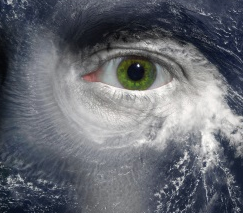Originally published in July, 2016
“At the still point of the turning world. Neither flesh nor fleshless;
Neither from nor towards; at the still point, there the dance is,
But neither arrest nor movement. And do not call it fixity,
Where past and future are gathered. Neither movement from nor towards,
Neither ascent nor decline. Except for the point, the still point,
There would be no dance, and there is only the dance.”
T.S. Eliot, “Burnt Norton”
“The middle way:” this may ring a bell if you are familiar with Buddhist philosophy. Sometimes Buddhism itself is called the Middle Way. Beyond Buddhism, most people are familiar with the concept of “middle:” the moderation, the space between, the “yes, and.” But perhaps you can observe afresh how the concept resonates with you at different times in your life. I’d like to share a couple of throughlines of research that helped me understand how it resonates with me at this time in my life—maybe you’ll also find some nuggets of inspiration.
The Corpus Callosum
My initial spark was an article I read about Leonardo Davinci and the possibility of his larger-than-average Corpus Callosum. Apparently, his mirror writing (ability to write from right to left and left to write with equal clarity) gives us a clue about his brain. Leonard Shlain notes that, “Based on what we can extrapolate from the brains of people who share Leonardo’s ability to mirror-write, the evidence points to the presence of a large Corpus Callosum that kept each hemisphere well informed as to what the other was doing.”
The Corpus Callosum is essentially a bridge. In order to function at our highest level, the information gathered from one side of the hemisphere must be communicated to the other hemisphere. It is like a crack between worlds. A pathway to make integration and communication possible.
Although the collective scientific understanding of the brain maps it with “centers” of emotion, “types” of intelligence, localizations, right brain/left brain divisions, as well as recent metaphors of ecosystems and networks, we mustn’t forget two key points: the brain is indeed one unified mass, and messages of the specialized sections pass through the middle Corpus Collosum in order to inform the other sections.
Leonardo Davinci was a special kind of genius in that he excelled and innovated in both art and science. Shlain notes that this might also be evidence of a thick and strong Corpus Callosum. It seems that a strong bridge is one that passes information back and forth frequently and thoroughly. It reminds me of oscillating waves. Imagine these waves oscillating quicker and quicker until they oscillate so quickly they almost look like a single line. The more the hemispheres talk to each other freely, the more they begin to function as one unified entity, via the Corpus Callosum.
It’s important to consider the other specific brain structures that are all around this middle section. In this fascinating essay, Gary Osborn points out that the thalamus, the pituitary gland, and the pineal gland are all worthy of special attention.
The “third eye” referenced in certain spiritual traditions (the Ajna chakra, the seat of seeing and understanding many overlaying worlds, observing, and experiencing that which transcends time) may relate to the Corpus Callosum generally, or maybe specifically the pineal gland, or pituitary, or thalamus, or maybe all of the above? Osborn seems to be in the thalamus-as-seat-of-soul school of thought. There are even academic inquiries regarding the Corpus Callosum area and possible relationship to the Eye of Horus. Check this out:
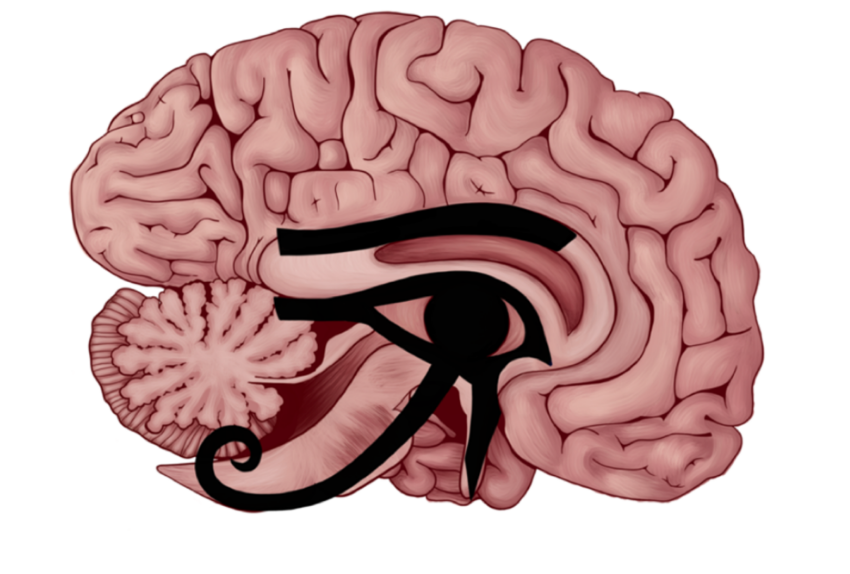
In any case, many philosophers and spiritualists seem to be in agreement that bringing awareness to that entire middle area will have positive blossoming effects.
Furthermore, the Corpus Callosum and pineal gland relationship may somehow mirror the connection between the vagina and the clitoris. The image below reinforced that thought for me. This article published by MIT notes, “many sympathetic nerve endings terminate directly on the pineal cells, instead of on blood vessels or smooth muscle cells as in most other organs.”
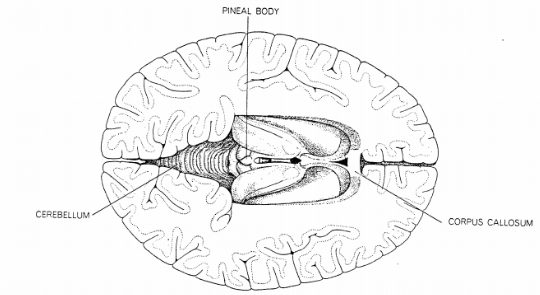
It makes sense kinesthetically as well. There are some wonderful tantric breathing exercises out there in which you might discover how bringing heightened awareness to the clitoral area can stimulate energy that flows upwards and stimulates the pineal gland/Corpus Callosum area—it is a potent experience.
Let’s now allow this brain investigation to lead us outward.
“The Brain—is wider than the Sky—
For—put them side by side—
The one the other will contain
With ease—and You—beside—
The Brain is deeper than the sea—
For—hold them—Blue to Blue—
The one the other will absorb—
As Sponges—Buckets—do—
The Brain is just the weight of God—
For—Heft them—Pound for Pound—
And they will differ—if they do—
As Syllable from Sound—”
— Emily Dickinson, ca. 1862
The Mind and Trance States
F. Scott Fitzgerald said that “The test of a first-rate intelligence is the ability to hold two opposed ideas in the mind at the same time, and still retain the ability to function.”
Oppositions are part of the physical world. In a human body, we get to explore these oppositions, play with them, balance them. I would venture to say that masters of Fitzgerald’s idea are people like actors, dancers, poets, people who are aware of going in and out of trance. These people are comfortable with living in at least two worlds at once and still functioning. Butoh dance taught me what it means to keep one foot in the physical world, and one foot in the world of everything else happening on other planes (spiritual, ancestral, or otherwise). Actors do it too: they keep one foot in the world of “themselves” and one foot in the world of “the other.” They are an antennae-like, bridge-like Corpus Callosums receiving, channeling, expressing information from different parts of this cosmic brain.
Poets also understand the middle-way bridge: by speaking and writing in poetic metaphor, they activate both hemispheres simultaneously— both the left side, which processes language, as well as the right side, which processes more of the intuitive and imagistic.
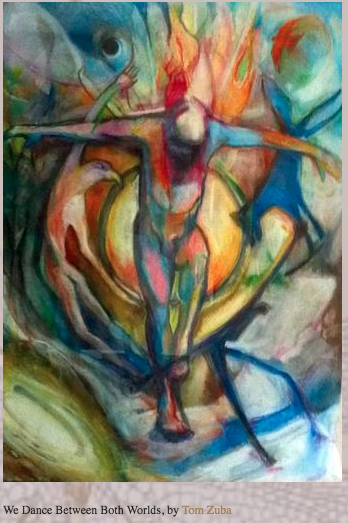
In hypnosis, there are many ways of finding a middle-way balance between attention and relaxation, which measurably alters your brainwaves, guiding you into a deep flow state, a very receptive, creative state of mind.
The Body’s Oppositions and Centers
Just as the brain has its center, think about how the spine marks the relative center of the body and notice the semi-symmetries, as well as the differences (like the hemispheres). Often in performance arts classes, the first task the student is set to is “centering themselves.” How do you balance your head, heart, and pelvis? How can you spread your weight equally between your feet? How can your body find a sense of ease vertically, your body being like a center point between heaven and earth? What does “centering” mean and feel like to unique bodies, how do you know when you are in your center?
I’ve come across some simple physical exercises which strengthen your middle-way bridge by either reinforcing the integration of brain hemispheres or inviting a balance between tension and relaxation. Here are some ideas:
- Alternate nostril breathing
- Draw large figure 8’s across the body and using different body parts (i.e draw figure 8’s in the air with your toes, knees, etc)
- Yoga: most poses will be great for this, but try Eagle Pose specifically
- Perform daily tasks such as brushing teeth, eating, or writing with the opposite hand that you are accustomed to using. Or/also perform a task with both hands simultaneously (i.e. stir two cups of coffee at the same time, catch a ball in each hand at the same time)
- Practice reading and writing in mirror language
- Study visual illusion images (the ones where different things pop out depending on how you focus on it)
- Sit in a chair and practice relaxing every single muscle and bone in your body, then practice tensing and clenching as much as you can, and then try to find the perfect middle amount of tension and relaxation that comfortably holds you in a chair
- Hold your arms out to the sides and throw a ball from one hand to the other, watching the ball with your eyes as you go
- Just go for a walk! Take in your surroundings. Notice your feet as you walk. Notice the things you didn’t notice before. Notice your breath. Maybe sing while you walk!
- An idea I learned from Min Tanaka: lay a piece of yarn in a straight line. Start at the back of the string, with both feet on the string, heel-to-toe, the string exactly in the middle of the feet. Focus all your attention on feeling the string in the middle of the sole of the feet. Experiment with walking forwards, backwards, eyes open, eyes closed, but always sensing the string.
- Play with shifting awareness in movement improvisation. Where is your center at any given moment? Even in an unusual body shape, can you feel your center? Where is the center of the space itself? How are you in relation to spatial center?
Theatre, Community, and the Planet
Currently, I am attending a 3-week physical theatre workshop at the Dell’Arte International Summer Intensive in Blue Lake, California. One of the key themes of our daily practice is “finding 2nd circle.” The “circles” are a way of defining your state: 1st circle is generally a little collapsed on yourself, stuck in the past, energy inward into your own thoughts. 3rd circle is forward and future focused, puffed outwards, a little aggressive, maybe a little show-offy.
Then there is 2nd circle: the middle path between 1st and 3rd. Radical presence and availability. Centered. Connected with what is in the moment. The exact middle between tension and relaxation. This is the still point of the turning world that Eliot speaks of, the “neither from nor towards.” From the 2nd circle center point, anything is possible. You are ready to play in unexpected ways.
Staying in 2nd circle in a community of people helps heal that community as the members become radically present with each other and the infinite possibilities therein. As I have experienced during just the first week in Blue Lake, a community that begins from a place of 2nd circle is a community in which the members have a kinesthetic awareness of when to move, when to wait, when to change, where to go. They are unified in this kind of agreement, yet there is generosity and spaciousness to express the individual impulses in response to one another. They are in a communal flow that suspends judgement as they set about their tasks. They are open to all possibilities.
So now, my question is: can we take this idea further? I have seen this model working in small groups. Can we create larger communities that dwell in the 2nd circle, communities of communities striving to stay present in such a way?
The planet is inherently 2nd circle. Look at the plants and animals around you. They are not in the future or past, they are available to each other, alert, ready. It’s human people who too often dwell in 1st or 3rd circle. And it’s partly because of our complicated brains, emotional selves, analytical desires, and of course ego… it takes some effort for the human to deal with these things and re-learn what 2nd circle really means. For me, somatic therapy and body-based work especially seem to encourage presence and curiosity and to make dynamic social connection available to me again. Safe, consensual touch brings a body into the relational NOW, with a sense of care and compassion.
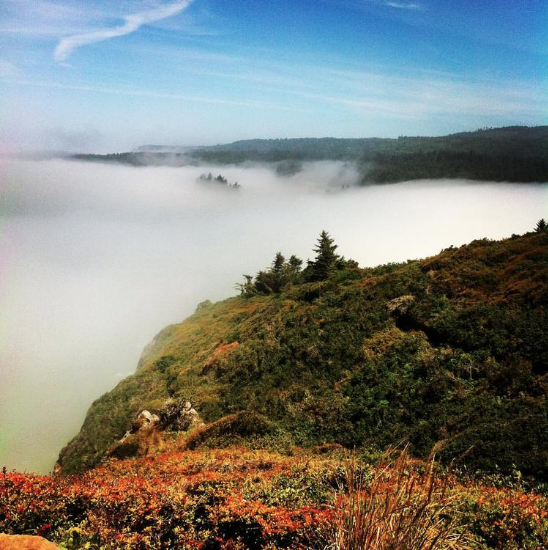
Trinidad Head, California! The mist and stones and trees are SO PRESENT!
Just how far can we move the magical center point out of the Corpus Callosum and the centers of the body, through community, through entire regions? Isn’t this planet the real center of Earth-dwelling humanity? What if we collectively and intentionally thought of Earth as the Corpus Callosum for all Earth-dwellers? It sounds a little strange, but maybe it’s not so hard. Maybe it simply starts with the feelings and reality of “rooting into the earth,” “grounding,” and tapping into the “still point of the turning world.”
